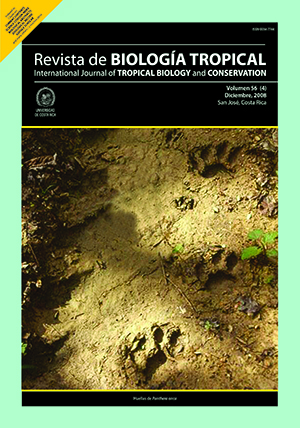Abstract
The fern Blechnum sprucei grows in Mesoamerica (Costa Rica) and South America, from Colombia to Bolivia, south-east and centre of Brazil, Paraguay and Argentina. It is a distinctive, somewhat vulnerable, mostly orophilous species. Fresh and dry herbarium material was used for this study. Herbarium material for anatomical studies comes from CTES, BA, LP, MA, SI and UC (Holmgren et al.1990). Selected representative specimens are additionally cited after taxonomic treatment of the species. Dry material was restored with aqueous 4:1 butil cellosolve. Pinnae were cleared with aqueous 6% NaOH, then coloured with aqueous 1 % TBO (Gurr 1966). Hand made transverse sections of young and adult stipes, and costae were done in fresh and restored herbarium material. Venation and epidermal patterns were analyzed in basal, apical and medium pinnae, but only the latter were illustrated. The size and density of stomata were measured in medium pinnae from all studied samples, values shown are the average of 25 measures per sample; sizes are expressed as minimum, media and maximum length x width, in µm, and density as minimum, media and maximum number of stomata / mm2. Spores were studied with SEM, mounted on metal stubs with double sided tape, covered with gold under vacuum and photographed with a Jeol /EO JSM 6360 (15 KV) SEM. Spores were also studied with light microscope, mounted in DePeX (DePeX mounting medium, Gurr, BDH Laboratory Supplies, Poole BH15 1TD, UK) and measured using an ocular micrometer. Measurements are based on a minimum sample of 100 spores taken from different specimens. Sizes are expressed as the longest equatorial diameter/ polar diameter, in µm. Gametophytes were studied from material collected in the subtropical forest of Tucumán Province, Argentina. Spore samples for cultures were taken from single sporophytes kept dry at room temperature since the date plants were collected. Gametophytes were grown under fluorescent light. Multispore cultures were established on mineral agar. Percentage of germination was recorded for a random sample of 50 spores from each of the two plates, every three days until there was no further increasing. Gametophytes were stained with chloral hydrate acetocarmine. The species has large sporophytes, suberect, scaly rhizomes, and dimorphic fronds with short, scaly stipes and lanceolate to elliptic sterile laminae. The rachises can grow indefinitely as radicant axis that vegetatively multiplicate the plants. Pinnae are lanceolate, herbaceous, with crenate and papillose margins, superficially scaly and hairy, peciolulate, with free, visible veins regularly once furcated near the costa, ending in large, active hydathodes. The broadly elliptic fertile laminae bear distant pinnae, with vegetative tissue reduced to the portion that supports the indusium and the continuous coenosorus; terminal indefinite rachis, not proliferous, may be present.Comments

This work is licensed under a Creative Commons Attribution 4.0 International License.
Copyright (c) 2008 Revista de Biología Tropical
Downloads
Download data is not yet available.






